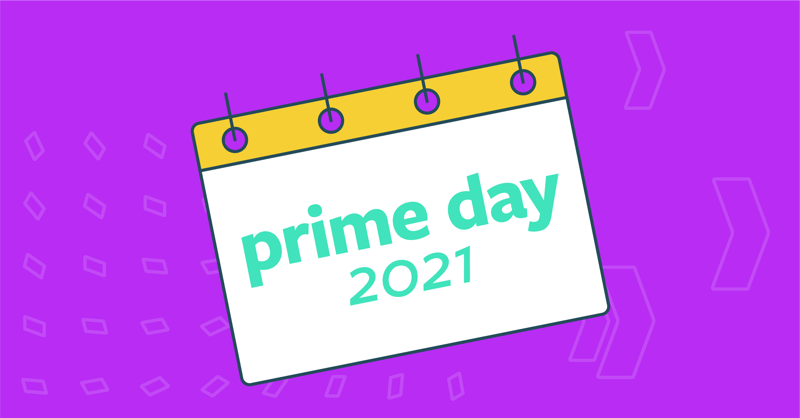
Ah, Prime Day. 2021 marks the sixth year running of the epic multi-day shopping event that has altered how consumers and retailers of all sizes approach summer savings. Last year due to the pandemic, Amazon moved it to October, which sparked an early kickoff to the 2020 holiday season and resulted in a whopping $10B in global Prime Day sales.
With Amazon closing out the first quarter showing record marketplace growth—60% growth in Q1 2021—this year’s Prime Day is intended to be even bigger as more consumers continue to buy more things online (see Trend #7 here for info on climbing ecommerce adoption rates).
Since Amazon kept official dates a secret for months, the biggest question on many brands’ and Amazon Prime sellers’ minds right now is when is Prime Day this year? Amazon Prime Day 2021 will be held on June 21 and 22, which is a tad earlier than the usual mid-July slot and a typically slower time for retail.
The earlier event date has kept brands, retailers, and other marketplaces (Target, Walmart) who hope to run competing promotions on their toes and scrambling to shift plans ahead of schedule. A June date has some wondering if Amazon intends to run a second event this fall to repeat the 2020 holiday season success again in 2021. An earlier Prime Day may also usher in an earlier back-to-school shopping season.
Important note: Prime Day 2021 has been paused in Canada based on the increasing impact of COVID-19.
Amazon moved Prime Day 2020 back to October due to challenges the company faced filling orders during the pandemic. Over a year later, these issues are still abundantly present and continue to haunt sellers hoping to take advantage of the guaranteed lift Prime Day provides.
We’ll talk more below about how to accurately forecast for Prime Day 2021, but it’s also key to keep the rest of the year in mind, too—since it doesn’t seem likely a solution for supply chain problems will be found anytime soon. Follow our Amazon 2021 FBA Calendar to stay on track.
Here are the Prime Day-specific deadlines you need to know:
You won’t win Prime Day customers if your products aren’t in stock on Amazon. With May inventory deadlines fast approaching, quickly forecasting the right amount of inventory to have on hand for Prime Day may seem difficult, especially during an ongoing pandemic. There's nothing worse (or more frustrating) than having orders you can’t fulfill due to a lack of inventory.
Take the time to analyze how much inventory to send in based on last year’s sales, increased or decreased demand for certain products this year, and keep track of how long it will take to be processed, categorized, and appear in stock on Amazon. The sooner you can send things in right now, the better. Based on the Prime Day deadlines above, your planning needs to have happened yesterday—so please reach out asap if you need help with Prime Day or other seasonal/holiday forecasting.
Millions of shoppers are browsing Amazon Prime Day for the steep discounts—take advantage of the sheer volume of potential customers and update your promotions accordingly. Attract deal-seeking shoppers with Coupons and Prime Exclusive Discounts, which make your product stand out (they’re tagged on Amazon with a “Prime Day Deal” label) and increase your click-through rate during the event. Keep in mind: These discounts need to be updated two weeks before the event date.
Small and medium businesses thrived during Prime Day 2020 with record-breaking sales, nearly a 60% increase over Prime Day 2019. Headed into this year, the brand competition has never been higher to capture and convert customers. So how do you set your brand apart from everyone selling a similar product to yours during Prime Day? Build a solid Amazon Storefront.
Though Amazon Stores have been around for some time now, they’ve been drastically underutilized, so you’ll be one step ahead of the competition if you create and/or optimize yours right now. Your Storefront operates as a mini website for your brand on the Amazon platform, allowing you to showcase your full product assortment (hello upsell and cross-sell opportunities!), customize with personalized branding and logos, and use it as a landing page for ads during Prime Day 2021. You can also add branded video to your Storefront—take a look at how we did that with our agency partner at Necklet on Amazon.
Already have a thoughtfully designed Storefront? Consider updating your current Amazon Store to showcase certain products, deals, and messaging just for Prime Day crowds.
The pandemic has changed the way consumers shop and trust brands on marketplaces. Amazon customers now crave authenticity and complete transparency. Gone are the days where a minimally optimized listing will give them the information and reassurance they need to make the purchase.
Echoing the emphasis you should be placing on your Amazon Store, be sure to share your unique brand story and bring your company’s mission front and center on your listings, too. This means professional photography, content, and graphics that answer any questions Prime shoppers may have about your products before purchasing. This includes:
Strategic advertising during Prime Day is a must. There’s going to be a lot more traffic on Amazon than usual at this time, which means you need to be prepared for higher CPCs. Prime Day is a high-competition event for advertising, and spending more is the only way to make sure your ads are seen—increase your daily campaign budgets to 2-3x their normal daily allocation.
Ideally, you should start running Prime Day campaigns at least two weeks in advance. That allows your campaigns to earn sales history, which increases their authority within Amazon's platform, as well as allows you to optimize where and when needed. If you turn your campaigns on for the first time on Prime Day, you probably won't be successful. Keep a close eye on the performance of your Sponsored Products, Sponsored Brands, Sponsored Display, and Sponsored Display Video ads leading up to, during, and after Prime Day and adjust accordingly.
Also consider driving traffic from Facebook, influencer marketing, and other sites to your Amazon store and product listings during Prime Day. Amazon Attribution can help with that.
The last thing you want to do is throw a bunch of money at ads that aren’t converting, or realize after the fact that your listing was suppressed or something appeared wonky on your product page that cost you sales. Use the time between the first day and the second to evaluate your day one activity and results. Is there anything about your strategy that needs to be changed heading into day two?
Prime Day anxiety is real for many brands and it’s easy to get lost in the chaos, but taking the time to check in on how your products are performing throughout the day is vital—not only to your Prime Day success but for other peak seasons and Black Friday/Cyber Monday, too.
Lorem ipsum dolor sit amet, consectetur adipiscing elit


Sign up to receive our newsletter for growth strategies, important updates, inventory and policy changes, and best practices.
These Stories on SupplyKick
For press inquiries, please contact Molly Horstmann, mhorstmann@supplykick.com